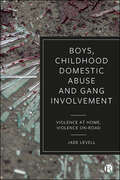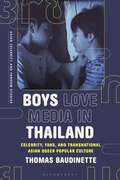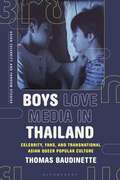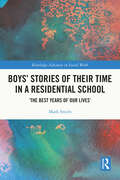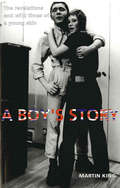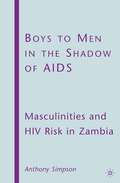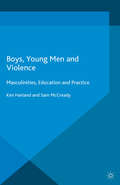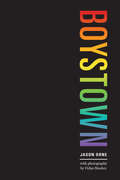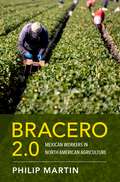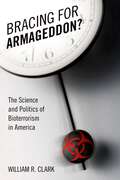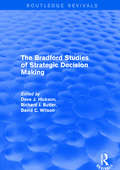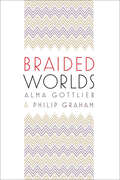- Table View
- List View
Boys, Childhood Domestic Abuse, and Gang Involvement: Violence at Home, Violence On-Road
by Jade LevellBoys and young men have been previously overlooked in domestic violence and abuse policy and practice, particularly in the case of boys who are criminalized and labelled as gang-involved by the time they reach their teens. Jade Levell offers radical and important insights into how boys in this context navigate their journey to manhood with the constant presence of violence in their lives, in addition to poverty and racial marginalization. Of equal interest to academics and front-line practitioners, the book highlights the narratives of these young men and makes practice recommendations for supporting these ‘hidden victims’.
Boys Love Media in Thailand: Celebrity, Fans, and Transnational Asian Queer Popular Culture (Asian Celebrity and Fandom Studies)
by Thomas BaudinetteOver the past several years, the Thai popular culture landscape has radically transformed due to the emergence of “Boys Love” (BL) soap operas which celebrate the love between handsome young men. Boys Love Media in Thailand: Celebrity, Fans, and Transnational Asian Queer Popular Culture is the first book length study of this increasingly significant transnational pop culture phenomenon. Drawing upon six years of ethnographic research, the book reveals BL's impacts on depictions of same-sex desire in Thai media culture and the resultant mainstreaming of queer romance through new forms of celebrity and participatory fandom. The author explores how the rise of BL has transformed contemporary Thai consumer culture, leading to heterosexual female fans of male celebrities who perform homoeroticism becoming the main audience to whom Thai pop culture is geared. Through the case study of BL, this book thus also investigates how Thai media is responding to broader regional trends across Asia where the economic potentials of female and queer fans are becoming increasingly important. Baudinette ultimately argues that the center of queer cultural production in Asia has shifted from Japan to Thailand, investigating both the growing international fandom of Thailand's BL series as well as the influence of international investment into the development of these media. The book particularly focuses on specific case studies of the fandom for Thai BL celebrity couples in Thailand, China, the Philippines, and Japan to explore how BL series have transformed each of these national contexts' queer consumer cultures.
Boys Love Media in Thailand: Celebrity, Fans, and Transnational Asian Queer Popular Culture (Asian Celebrity and Fandom Studies)
by Thomas BaudinetteOver the past several years, the Thai popular culture landscape has radically transformed due to the emergence of “Boys Love” (BL) soap operas which celebrate the love between handsome young men. Boys Love Media in Thailand: Celebrity, Fans, and Transnational Asian Queer Popular Culture is the first book length study of this increasingly significant transnational pop culture phenomenon. Drawing upon six years of ethnographic research, the book reveals BL's impacts on depictions of same-sex desire in Thai media culture and the resultant mainstreaming of queer romance through new forms of celebrity and participatory fandom. The author explores how the rise of BL has transformed contemporary Thai consumer culture, leading to heterosexual female fans of male celebrities who perform homoeroticism becoming the main audience to whom Thai pop culture is geared. Through the case study of BL, this book thus also investigates how Thai media is responding to broader regional trends across Asia where the economic potentials of female and queer fans are becoming increasingly important. Baudinette ultimately argues that the center of queer cultural production in Asia has shifted from Japan to Thailand, investigating both the growing international fandom of Thailand's BL series as well as the influence of international investment into the development of these media. The book particularly focuses on specific case studies of the fandom for Thai BL celebrity couples in Thailand, China, the Philippines, and Japan to explore how BL series have transformed each of these national contexts' queer consumer cultures.
Boys’ Stories of Their Time in a Residential School: ‘The Best Years of Our Lives’ (Routledge Advances in Social Work)
by Mark SmithThis book provides rich insights into the pre and post care experiences of boys who were pupils in a residential school where the author worked over the course of the 1980s. It describes the boys’ trajectories through life, as well as detailing the rhythms, rituals, routines, and relationships that existed in the school. While the focus is on the (former) boys’ experiences, these are augmented by interview material from staff members, including religious Brothers, who worked in the school. Together, these different perspectives provide unique insights into an area of social work history that is ill-served by existing accounts, making the book required reading for all scholars and students of social work; social and oral history; narrative sociology; criminology and desistance and social policy.
Boys’ Stories of Their Time in a Residential School: ‘The Best Years of Our Lives’ (Routledge Advances in Social Work)
by Mark SmithThis book provides rich insights into the pre and post care experiences of boys who were pupils in a residential school where the author worked over the course of the 1980s. It describes the boys’ trajectories through life, as well as detailing the rhythms, rituals, routines, and relationships that existed in the school. While the focus is on the (former) boys’ experiences, these are augmented by interview material from staff members, including religious Brothers, who worked in the school. Together, these different perspectives provide unique insights into an area of social work history that is ill-served by existing accounts, making the book required reading for all scholars and students of social work; social and oral history; narrative sociology; criminology and desistance and social policy.
A Boy's Story: The Revelations and Wild Times of a Young Skin
by Martin KingAs the 1960's drew to a close, parents across Britain raised a curious eyebrow as their long-haired children suddenly returned home with shaven heads, sporting Levi's jeans and vicious looking army boots, pleading for three quid to buy a Harrington jacket from the market. The skinhead was born and a youth culture stronger and more widespread than any other, before or since, took Britain by storm. Marting King was one of them. Boys and girls alike embraced this new working-class fashion and music - the West Indian reggae sounds of Blue Beat and the strong sense of identity they fostered. For a couple of summers the media would have it that England was under seige, when the young skins paraded at seaside resorts on bank holidays and later on terraces at nearly every football ground acros the country. With his passion for Chelsea FC and their growing reputation as the skinhead club forming a backdrop, King artfully and humorously describes the heady mix of pleasures which were all part of life as a teenager growing up in working-class south London in the late 60's
Boys to Men in the Shadow of AIDS: Masculinities and HIV Risk in Zambia
by A. SimpsonThis ethnography charts the lives of mission-educated men in Zambia and their search for meaning in the AIDS pandemic, as well as their responses to prevention and HIV testing. It also suggests how hegemonic masculinities may begin to be re-figured and gender relationships redesigned.
Boys, Young Men and Violence: Masculinities, Education and Practice
by Ken Harland Sam McCreadyThis book draws upon data collected over an 18 year period with over 1000 boys and young men across Northern Ireland. Providing critical reflections on violence, masculinity and education, it uses the voices and experiences of young men to inform and influence research, practice and policy.
Boystown: Sex and Community in Chicago
by Jason OrneFrom neighborhoods as large as Chelsea or the Castro, to locales limited to a single club, like The Shamrock in Madison or Sidewinders in Albuquerque, gay areas are becoming normal. Straight people flood in. Gay people flee out. Scholars call this transformation assimilation, and some argue that we—gay and straight alike—are becoming “post-gay.” Jason Orne argues that rather than post-gay, America is becoming “post-queer,” losing the radical lessons of sex. In Boystown, Orne takes readers on a detailed, lively journey through Chicago’s Boystown, which serves as a model for gayborhoods around the country. The neighborhood, he argues, has become an entertainment district—a gay Disneyland—where people get lost in the magic of the night and where straight white women can “go on safari.” In their original form, though, gayborhoods like this one don’t celebrate differences; they create them. By fostering a space outside the mainstream, gay spaces allow people to develop an alternative culture—a queer culture that celebrates sex. Orne spent three years doing fieldwork in Boystown, searching for ways to ask new questions about the connective power of sex and about what it means to be not just gay, but queer. The result is the striking Boystown, illustrated throughout with street photography by Dylan Stuckey. In the dark backrooms of raunchy clubs where bachelorettes wouldn’t dare tread, people are hooking up and forging “naked intimacy.” Orne is your tour guide to the real Boystown, then, where sex functions as a vital center and an antidote to assimilation.
Boystown: Sex and Community in Chicago
by Jason OrneFrom neighborhoods as large as Chelsea or the Castro, to locales limited to a single club, like The Shamrock in Madison or Sidewinders in Albuquerque, gay areas are becoming normal. Straight people flood in. Gay people flee out. Scholars call this transformation assimilation, and some argue that we—gay and straight alike—are becoming “post-gay.” Jason Orne argues that rather than post-gay, America is becoming “post-queer,” losing the radical lessons of sex. In Boystown, Orne takes readers on a detailed, lively journey through Chicago’s Boystown, which serves as a model for gayborhoods around the country. The neighborhood, he argues, has become an entertainment district—a gay Disneyland—where people get lost in the magic of the night and where straight white women can “go on safari.” In their original form, though, gayborhoods like this one don’t celebrate differences; they create them. By fostering a space outside the mainstream, gay spaces allow people to develop an alternative culture—a queer culture that celebrates sex. Orne spent three years doing fieldwork in Boystown, searching for ways to ask new questions about the connective power of sex and about what it means to be not just gay, but queer. The result is the striking Boystown, illustrated throughout with street photography by Dylan Stuckey. In the dark backrooms of raunchy clubs where bachelorettes wouldn’t dare tread, people are hooking up and forging “naked intimacy.” Orne is your tour guide to the real Boystown, then, where sex functions as a vital center and an antidote to assimilation.
Boystown: Sex and Community in Chicago
by Jason OrneFrom neighborhoods as large as Chelsea or the Castro, to locales limited to a single club, like The Shamrock in Madison or Sidewinders in Albuquerque, gay areas are becoming normal. Straight people flood in. Gay people flee out. Scholars call this transformation assimilation, and some argue that we—gay and straight alike—are becoming “post-gay.” Jason Orne argues that rather than post-gay, America is becoming “post-queer,” losing the radical lessons of sex. In Boystown, Orne takes readers on a detailed, lively journey through Chicago’s Boystown, which serves as a model for gayborhoods around the country. The neighborhood, he argues, has become an entertainment district—a gay Disneyland—where people get lost in the magic of the night and where straight white women can “go on safari.” In their original form, though, gayborhoods like this one don’t celebrate differences; they create them. By fostering a space outside the mainstream, gay spaces allow people to develop an alternative culture—a queer culture that celebrates sex. Orne spent three years doing fieldwork in Boystown, searching for ways to ask new questions about the connective power of sex and about what it means to be not just gay, but queer. The result is the striking Boystown, illustrated throughout with street photography by Dylan Stuckey. In the dark backrooms of raunchy clubs where bachelorettes wouldn’t dare tread, people are hooking up and forging “naked intimacy.” Orne is your tour guide to the real Boystown, then, where sex functions as a vital center and an antidote to assimilation.
Boystown: Sex and Community in Chicago
by Jason OrneFrom neighborhoods as large as Chelsea or the Castro, to locales limited to a single club, like The Shamrock in Madison or Sidewinders in Albuquerque, gay areas are becoming normal. Straight people flood in. Gay people flee out. Scholars call this transformation assimilation, and some argue that we—gay and straight alike—are becoming “post-gay.” Jason Orne argues that rather than post-gay, America is becoming “post-queer,” losing the radical lessons of sex. In Boystown, Orne takes readers on a detailed, lively journey through Chicago’s Boystown, which serves as a model for gayborhoods around the country. The neighborhood, he argues, has become an entertainment district—a gay Disneyland—where people get lost in the magic of the night and where straight white women can “go on safari.” In their original form, though, gayborhoods like this one don’t celebrate differences; they create them. By fostering a space outside the mainstream, gay spaces allow people to develop an alternative culture—a queer culture that celebrates sex. Orne spent three years doing fieldwork in Boystown, searching for ways to ask new questions about the connective power of sex and about what it means to be not just gay, but queer. The result is the striking Boystown, illustrated throughout with street photography by Dylan Stuckey. In the dark backrooms of raunchy clubs where bachelorettes wouldn’t dare tread, people are hooking up and forging “naked intimacy.” Orne is your tour guide to the real Boystown, then, where sex functions as a vital center and an antidote to assimilation.
Boystown: Sex and Community in Chicago
by Jason OrneFrom neighborhoods as large as Chelsea or the Castro, to locales limited to a single club, like The Shamrock in Madison or Sidewinders in Albuquerque, gay areas are becoming normal. Straight people flood in. Gay people flee out. Scholars call this transformation assimilation, and some argue that we—gay and straight alike—are becoming “post-gay.” Jason Orne argues that rather than post-gay, America is becoming “post-queer,” losing the radical lessons of sex. In Boystown, Orne takes readers on a detailed, lively journey through Chicago’s Boystown, which serves as a model for gayborhoods around the country. The neighborhood, he argues, has become an entertainment district—a gay Disneyland—where people get lost in the magic of the night and where straight white women can “go on safari.” In their original form, though, gayborhoods like this one don’t celebrate differences; they create them. By fostering a space outside the mainstream, gay spaces allow people to develop an alternative culture—a queer culture that celebrates sex. Orne spent three years doing fieldwork in Boystown, searching for ways to ask new questions about the connective power of sex and about what it means to be not just gay, but queer. The result is the striking Boystown, illustrated throughout with street photography by Dylan Stuckey. In the dark backrooms of raunchy clubs where bachelorettes wouldn’t dare tread, people are hooking up and forging “naked intimacy.” Orne is your tour guide to the real Boystown, then, where sex functions as a vital center and an antidote to assimilation.
Boystown: Sex and Community in Chicago
by Jason OrneFrom neighborhoods as large as Chelsea or the Castro, to locales limited to a single club, like The Shamrock in Madison or Sidewinders in Albuquerque, gay areas are becoming normal. Straight people flood in. Gay people flee out. Scholars call this transformation assimilation, and some argue that we—gay and straight alike—are becoming “post-gay.” Jason Orne argues that rather than post-gay, America is becoming “post-queer,” losing the radical lessons of sex. In Boystown, Orne takes readers on a detailed, lively journey through Chicago’s Boystown, which serves as a model for gayborhoods around the country. The neighborhood, he argues, has become an entertainment district—a gay Disneyland—where people get lost in the magic of the night and where straight white women can “go on safari.” In their original form, though, gayborhoods like this one don’t celebrate differences; they create them. By fostering a space outside the mainstream, gay spaces allow people to develop an alternative culture—a queer culture that celebrates sex. Orne spent three years doing fieldwork in Boystown, searching for ways to ask new questions about the connective power of sex and about what it means to be not just gay, but queer. The result is the striking Boystown, illustrated throughout with street photography by Dylan Stuckey. In the dark backrooms of raunchy clubs where bachelorettes wouldn’t dare tread, people are hooking up and forging “naked intimacy.” Orne is your tour guide to the real Boystown, then, where sex functions as a vital center and an antidote to assimilation.
Bracero 2.0: Mexican Workers in North American Agriculture
by Philip MartinRising consumer demand for fresh fruits and vegetables has led to the employment of five million Mexican-born workers on North American farms during a typical year. The migration of Mexican workers within and from Mexico has implications for North American agriculture, labor, and economic development. For instance, the guest worker systems of Canada and the US allow Mexican workers to earn five times more in six months than they could earn in a year at home, fueling the construction of trophy homes in rural Mexico but not necessarily spurring economic development. The expansion of export agriculture encourages internal migration from south-to-north within Mexico, which moves migrants to areas that offer higher wages but may subject some migrants to exploitation. In Bracero 2.0, Philip Martin draws on decades of research and experience to explore the role of rural Mexicans in North American agriculture, as well as the implications for farm employers and farm workers, consumers, and the economies of North America. Martin assesses the historical and current demand for and supply of farm labor and the operation of farm labor markets in Canada, Mexico, and the US. He also uses statistical and survey data to provide the most reliable portrait of the five million people who work for wages on North American farms and explores alternatives to US farm workers in major fruits and vegetables, showing how changing consumer preferences can speed or slow mechanization. Bracero 2.0 concludes with options to improve protections for farm workers, highlighting the need for systems that ensure continuous labor law compliance--as with food safety--rather than compliance only for government or private audits.
Bracero 2.0: Mexican Workers in North American Agriculture
by Philip MartinRising consumer demand for fresh fruits and vegetables has led to the employment of five million Mexican-born workers on North American farms during a typical year. The migration of Mexican workers within and from Mexico has implications for North American agriculture, labor, and economic development. For instance, the guest worker systems of Canada and the US allow Mexican workers to earn five times more in six months than they could earn in a year at home, fueling the construction of trophy homes in rural Mexico but not necessarily spurring economic development. The expansion of export agriculture encourages internal migration from south-to-north within Mexico, which moves migrants to areas that offer higher wages but may subject some migrants to exploitation. In Bracero 2.0, Philip Martin draws on decades of research and experience to explore the role of rural Mexicans in North American agriculture, as well as the implications for farm employers and farm workers, consumers, and the economies of North America. Martin assesses the historical and current demand for and supply of farm labor and the operation of farm labor markets in Canada, Mexico, and the US. He also uses statistical and survey data to provide the most reliable portrait of the five million people who work for wages on North American farms and explores alternatives to US farm workers in major fruits and vegetables, showing how changing consumer preferences can speed or slow mechanization. Bracero 2.0 concludes with options to improve protections for farm workers, highlighting the need for systems that ensure continuous labor law compliance--as with food safety--rather than compliance only for government or private audits.
Bracing for Armageddon?: The Science and Politics of Bioterrorism in America
by William R. ClarkSince September 11th, the threat of a bioterrorist attack--massive, lethal, and unpreventable--has hung in the air over America. Bracing for Armageddon? offers a vividly written primer for the general reader, shedding light on the science behind potential bioterrorist attacks and revealing what could happen, what is likely to happen, and what almost certainly will not happen. The story opens with a riveting account of a bioterrorism scenario commissioned by the U.S. government. Using this doomsday tableau as a springboard, Clark reviews a host of bioterrorist threats (from agroterrorism to a poisoning of the water supply) and examines not only the worst-case menace of genetically engineered pathogens, but also the lethal agents on the CDC's official bioterrorism list, including Smallpox, Anthrax, Plague, Botulism, and Ebola. His overview of attempted bioterrorist attacks to date--such as the failed Aum Shinrikyo attempts in 1995 in Japan and the Anthrax attack in the US following 9/11--bolstered by interviews with a range of experts--shows why virtually all of these attempts have failed. Indeed, he demonstrates that a successful bioterrorism attack is exceedingly unlikely, while a major flu epidemic (such as the deadly epidemic of 1918 that killed millions worldwide) is a virtual certainty. Given the long odds of a bioterrorist attack, Clark asks, has the more than $40 billion the United States has dedicated to the defense against bioterrorism really been well spent? Is it time to move on to other priorities? In contrast to the alarmist fears stoked by the popular media, William Clark here provides a reassuring overview of what we really need to worry about--and what we don't.
The Bradford Studies of Strategic Decision Making
by David J. Hickson, Richard J. Butler and David C. WilsonThis title was first published in 2001. This volume brings together the 25-year output of the longest running programme of research into the making of decisions by top management. It describes and explains the processes of arriving at major decisions and how they are affected by the issue under decision, the form of organization and national differences and then, finally, success and failure in implementation. The programme continues with research on routes in successfully managing implementation.
The Bradford Studies of Strategic Decision Making
by Dave J. Hickson Richard J. Butler David C. WilsonThis title was first published in 2001. This volume brings together the 25-year output of the longest running programme of research into the making of decisions by top management. It describes and explains the processes of arriving at major decisions and how they are affected by the issue under decision, the form of organization and national differences and then, finally, success and failure in implementation. The programme continues with research on routes in successfully managing implementation.
Braided Worlds
by Alma Gottlieb Philip GrahamIn a compelling mix of literary narrative and ethnography, anthropologist Alma Gottlieb and writer Philip Graham continue the long journey of cultural engagement with the Beng people of Côte d’Ivoire that they first recounted in their award-winning memoir Parallel Worlds. Their commitment over the span of several decades has lent them a rare insight. Braiding their own stories with those of the villagers of Asagbé and Kosangbé, Gottlieb and Graham take turns recounting a host of unexpected dramas with these West African villages, prompting serious questions about the fraught nature of cultural contact. Through events such as a religious leader’s declaration that the authors’ six-year-old son, Nathaniel, is the reincarnation of a revered ancestor, or Graham’s late father being accepted into the Beng afterlife, or the increasing, sometimes dangerous madness of a villager, the authors are forced to reconcile their anthropological and literary gaze with the deepest parts of their personal lives. Along with these intimate dramas, they follow the Beng from times of peace through the times of tragedy that led to Côte d’Ivoire’s recent civil conflicts. From these and many other interweaving narratives—and with the combined strengths of an anthropologist and a literary writer—Braided Worlds examines the impact of postcolonialism, race, and global inequity at the same time that it chronicles a living, breathing village community where two very different worlds meet.
Braided Worlds
by Alma Gottlieb Philip GrahamIn a compelling mix of literary narrative and ethnography, anthropologist Alma Gottlieb and writer Philip Graham continue the long journey of cultural engagement with the Beng people of Côte d’Ivoire that they first recounted in their award-winning memoir Parallel Worlds. Their commitment over the span of several decades has lent them a rare insight. Braiding their own stories with those of the villagers of Asagbé and Kosangbé, Gottlieb and Graham take turns recounting a host of unexpected dramas with these West African villages, prompting serious questions about the fraught nature of cultural contact. Through events such as a religious leader’s declaration that the authors’ six-year-old son, Nathaniel, is the reincarnation of a revered ancestor, or Graham’s late father being accepted into the Beng afterlife, or the increasing, sometimes dangerous madness of a villager, the authors are forced to reconcile their anthropological and literary gaze with the deepest parts of their personal lives. Along with these intimate dramas, they follow the Beng from times of peace through the times of tragedy that led to Côte d’Ivoire’s recent civil conflicts. From these and many other interweaving narratives—and with the combined strengths of an anthropologist and a literary writer—Braided Worlds examines the impact of postcolonialism, race, and global inequity at the same time that it chronicles a living, breathing village community where two very different worlds meet.
Braided Worlds
by Alma Gottlieb Philip GrahamIn a compelling mix of literary narrative and ethnography, anthropologist Alma Gottlieb and writer Philip Graham continue the long journey of cultural engagement with the Beng people of Côte d’Ivoire that they first recounted in their award-winning memoir Parallel Worlds. Their commitment over the span of several decades has lent them a rare insight. Braiding their own stories with those of the villagers of Asagbé and Kosangbé, Gottlieb and Graham take turns recounting a host of unexpected dramas with these West African villages, prompting serious questions about the fraught nature of cultural contact. Through events such as a religious leader’s declaration that the authors’ six-year-old son, Nathaniel, is the reincarnation of a revered ancestor, or Graham’s late father being accepted into the Beng afterlife, or the increasing, sometimes dangerous madness of a villager, the authors are forced to reconcile their anthropological and literary gaze with the deepest parts of their personal lives. Along with these intimate dramas, they follow the Beng from times of peace through the times of tragedy that led to Côte d’Ivoire’s recent civil conflicts. From these and many other interweaving narratives—and with the combined strengths of an anthropologist and a literary writer—Braided Worlds examines the impact of postcolonialism, race, and global inequity at the same time that it chronicles a living, breathing village community where two very different worlds meet.
Braided Worlds
by Alma Gottlieb Philip GrahamIn a compelling mix of literary narrative and ethnography, anthropologist Alma Gottlieb and writer Philip Graham continue the long journey of cultural engagement with the Beng people of Côte d’Ivoire that they first recounted in their award-winning memoir Parallel Worlds. Their commitment over the span of several decades has lent them a rare insight. Braiding their own stories with those of the villagers of Asagbé and Kosangbé, Gottlieb and Graham take turns recounting a host of unexpected dramas with these West African villages, prompting serious questions about the fraught nature of cultural contact. Through events such as a religious leader’s declaration that the authors’ six-year-old son, Nathaniel, is the reincarnation of a revered ancestor, or Graham’s late father being accepted into the Beng afterlife, or the increasing, sometimes dangerous madness of a villager, the authors are forced to reconcile their anthropological and literary gaze with the deepest parts of their personal lives. Along with these intimate dramas, they follow the Beng from times of peace through the times of tragedy that led to Côte d’Ivoire’s recent civil conflicts. From these and many other interweaving narratives—and with the combined strengths of an anthropologist and a literary writer—Braided Worlds examines the impact of postcolonialism, race, and global inequity at the same time that it chronicles a living, breathing village community where two very different worlds meet.
Braided Worlds
by Alma Gottlieb Philip GrahamIn a compelling mix of literary narrative and ethnography, anthropologist Alma Gottlieb and writer Philip Graham continue the long journey of cultural engagement with the Beng people of Côte d’Ivoire that they first recounted in their award-winning memoir Parallel Worlds. Their commitment over the span of several decades has lent them a rare insight. Braiding their own stories with those of the villagers of Asagbé and Kosangbé, Gottlieb and Graham take turns recounting a host of unexpected dramas with these West African villages, prompting serious questions about the fraught nature of cultural contact. Through events such as a religious leader’s declaration that the authors’ six-year-old son, Nathaniel, is the reincarnation of a revered ancestor, or Graham’s late father being accepted into the Beng afterlife, or the increasing, sometimes dangerous madness of a villager, the authors are forced to reconcile their anthropological and literary gaze with the deepest parts of their personal lives. Along with these intimate dramas, they follow the Beng from times of peace through the times of tragedy that led to Côte d’Ivoire’s recent civil conflicts. From these and many other interweaving narratives—and with the combined strengths of an anthropologist and a literary writer—Braided Worlds examines the impact of postcolonialism, race, and global inequity at the same time that it chronicles a living, breathing village community where two very different worlds meet.
Braided Worlds
by Alma Gottlieb Philip GrahamIn a compelling mix of literary narrative and ethnography, anthropologist Alma Gottlieb and writer Philip Graham continue the long journey of cultural engagement with the Beng people of Côte d’Ivoire that they first recounted in their award-winning memoir Parallel Worlds. Their commitment over the span of several decades has lent them a rare insight. Braiding their own stories with those of the villagers of Asagbé and Kosangbé, Gottlieb and Graham take turns recounting a host of unexpected dramas with these West African villages, prompting serious questions about the fraught nature of cultural contact. Through events such as a religious leader’s declaration that the authors’ six-year-old son, Nathaniel, is the reincarnation of a revered ancestor, or Graham’s late father being accepted into the Beng afterlife, or the increasing, sometimes dangerous madness of a villager, the authors are forced to reconcile their anthropological and literary gaze with the deepest parts of their personal lives. Along with these intimate dramas, they follow the Beng from times of peace through the times of tragedy that led to Côte d’Ivoire’s recent civil conflicts. From these and many other interweaving narratives—and with the combined strengths of an anthropologist and a literary writer—Braided Worlds examines the impact of postcolonialism, race, and global inequity at the same time that it chronicles a living, breathing village community where two very different worlds meet.
